If you’re standing in the aisle, staring at a wall of deck stains and feeling completely overwhelmed, I get it. I’ve been there. You want something that won’t peel in a year, something that makes your wood look rich and healthy, and something you won’t have to curse at when it’s time for a recoat.
That’s why I’m telling you to stop looking and pick up a can of Armstrong Clark stain. After years of trial and error with other brands, this is the one I trust on my own deck.
It’s more than just a color; it’s a long-term investment in the life of your wood and your own sanity.
My Experience With Armstrong Clark Stain
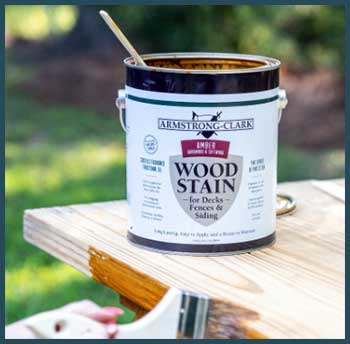
Let me take you back a few years.
My deck was my pride and joy, but its finish was becoming my recurring nightmare.
I’d started with a popular water-based stain from a big-box store.
It looked great for about eight months.
Then came the peeling.
The next summer, I had to rent a sander, spend a back-breaking weekend stripping it all down to bare wood, and start over. I tried a different brand, a so-called “hybrid oil,” and the results were disappointingly similar.
I was caught in a cycle of intense labor every other year, and I was starting to hate my deck.
My search for a better solution led me down a rabbit hole of online forums for professional wood restorers. One name kept popping up again and again: Armstrong Clark. The pros swore by it.
They talked about its unique formulation, its ease of use, and, most importantly, its graceful aging. No peeling, they said. Just a gentle fade over time. It sounded too good to be true, but I was desperate enough to try anything.
I ordered the Mountain Cedar semi-transparent stain. When it arrived, the first thing I noticed was the heft of the can and the rich, oily consistency. The prep work was still crucial, of course. I used a deck cleaner and a brightener to get my wood looking pristine and ready to absorb the new oil.
The day I chose to stain was a hot one here in central Pennsylvania, the kind of day my old stains would have gotten sticky and unmanageable. But Armstrong Clark went on like a dream. I applied it with a pad applicator, and it just seemed to melt into the wood.
There were no lap marks, no sticky spots, no flashing. I could work in the direct sun without a single issue. The product description says you can apply it in the heat of the day, and they aren’t kidding.
On my thirsty, older pine deck, that first coat drank up the stain. I followed the advice to apply a second “wet-on-wet” coat on the particularly dry sections. The result was a deep, rich color that looked incredibly natural.
It didn’t look like a film sitting on top of the wood; it looked like the wood itself was glowing from within. Fast forward three years, and the color had faded slightly, but there was zero peeling or flaking. Zero. Recoating was laughably simple. I cleaned the deck and applied a single maintenance coat.
That’s it. No stripping, no sanding. That experience sold me for life.
The Pros: Why I Stand By Armstrong Clark Stain?
When you find a product that saves you from hours of grueling labor and delivers a beautiful, long-lasting result, you want to shout it from the rooftops. My positive experience isn’t a fluke; it’s rooted in the very design of the product.
Let’s break down the specific advantages that make Armstrong Clark my go-to choice.
- A Forgiving and Straightforward Application
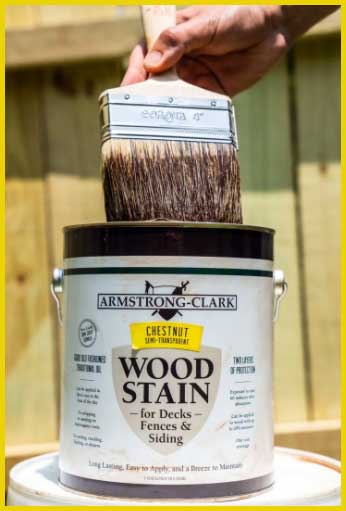
One of the biggest hurdles for any DIYer is the application process itself.
So many stains are finicky.
You worry about the temperature, the humidity, direct sunlight, and those dreaded lap marks.
Armstrong Clark removes so much of that anxiety.
The ability to apply it in the direct sun on a hot day is a massive benefit.
You aren’t restricted to staining only in the early morning or on a cloudy day.
This flexibility makes planning a large project so much easier.
Furthermore, it’s incredibly forgiving. Because it’s designed to penetrate, you don’t get the instant-drying surface film that causes other stains to show every overlap. If you have to stop and start, it’s much easier to blend the sections without leaving a visible line.
For me, this meant I could work at my own pace without stressing about creating a blotchy mess. It doesn’t get sticky or tacky during application, which is a common complaint with other oil-based products. It flows smoothly and evenly, making the physical act of staining less of a chore and more of a satisfying task.
- Deep Conditioning: Food for Your Wood
Here’s the real magic, the part that sets Armstrong Clark apart from the crowd. It’s not just a stain; it’s a conditioning treatment. The product description talks about a combination of drying and non-drying oils, and this isn’t just marketing jargon.
It’s the core of its performance. The non-drying oils are lighter and designed to separate from the formula, penetrating deep into the wood fibers. They essentially replace the wood’s own natural oils that have been lost to sun and rain over the years.
You can feel this as you apply it; the wood just seems to drink it in. This is what rejuvenates old, dry wood and keeps it from becoming brittle.
The drying oils in the formula stay closer to the surface. They cure and harden, locking in those conditioning oils and creating a protective barrier against moisture and UV rays. This two-pronged approach means you’re getting protection from the inside out.
It’s why the wood doesn’t just look good on the surface; it feels healthier and more stable. You’re not just painting a color on top; you’re feeding the very structure of the deck.
- Built to Last and Fade Gracefully
Longevity isn’t just about how many years a stain “lasts.” It’s about how it performs over that time and how easy it makes your life when it’s time for a refresh. This is where Armstrong Clark truly shines.
As I mentioned from my own experience, it doesn’t peel or crack. Because the protection is in the wood as much as it is on the wood, it can’t fail in the same way a surface film does. Instead of flaking off and exposing patches of bare wood, it fades gently and evenly over time.
This graceful aging process is the key to its easy maintenance. When you see the color lightening or find that water is starting to soak in rather than bead up, you know it’s time for a maintenance coat. And that process is as simple as cleaning the deck and applying a fresh coat of stain.
There’s no stripping, no heavy sanding, no media blasting. The time, money, and sheer physical effort this saves you over the lifespan of your deck is immense.
For me, recoating every three years with a simple clean and stain is infinitely better than stripping and sanding every two years with other brands.
The Not-So-Good Parts of Armstrong Clark Stain
No product is perfect for every single person or situation. To give you a complete picture, it’s important to talk about the aspects of Armstrong Clark that might be considered drawbacks or at least require some special attention.
Being aware of these things upfront will ensure you get the results you’re hoping for.
- The Stirring Saga: A Crucial Step
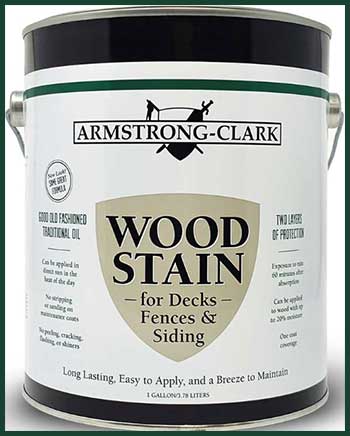
If there’s one piece of advice I’d hammer home, it’s this: you have to stir this stain, and you have to do it often.
The review that mentions keeping it stirred in the can or pan is spot on.
Because of its unique formula with different types of oils and pigments, the components can and will settle.
The heavier pigments and solids will sink to the bottom of the can.
If you just dip your brush in the top, you’ll be applying a much lighter, oil-heavy mixture with very little color.
As you get closer to the bottom of the can, the stain will get darker and darker. This will lead to a very uneven, blotchy finish on your deck.
You need to stir it thoroughly before you start, and you need to continue stirring it every 5-10 minutes during application. It’s not a huge chore—I just keep a mixing stick in my bucket—but it is a non-negotiable step.
Forgetting to do this is probably the number one cause of an unsatisfactory result with this product.
- Color Expectations and Wood Specifics
The sample chip in the store is a guide, not a guarantee. The final color of your project will vary, sometimes significantly, depending on the type of wood you have, its age, and how well you prepped it.
An old, porous pine deck will absorb the stain differently and look much different than a new, dense cedar deck. This is true for all stains, but it’s important to manage expectations with a penetrating oil like this one.
Furthermore, you need to pay attention to the recommendations for exotic hardwoods. The product information is very clear: for woods like Ipe or Mahogany, you should use the Amber, Mahogany, or Black Walnut colors.
These colors are formulated to penetrate those incredibly dense woods effectively. If you try to use a different color on your Ipe deck, you might find it doesn’t absorb properly and just sits on the surface, creating a sticky mess.
Always, always do a test spot on a small, inconspicuous area of your actual deck wood before you commit to staining the whole thing.
- The Initial Investment
Let’s be direct: Armstrong Clark is not the cheapest stain on the shelf. When you look at the price per gallon, it is a premium product, and it costs more than many of the brands you’ll find at a typical home improvement superstore.
For some, this higher initial cost might be a significant barrier. It can be tempting to go for the cheaper option, especially if you have a very large deck to cover.
However, I firmly believe this is a classic case of “you get what you pay for.” You have to look at the total cost of ownership over time. If you buy a cheaper stain that you have to strip and reapply every two years, you need to factor in the cost of strippers, sanders, your own time, and the stain itself multiple times.
With Armstrong Clark, the higher initial cost is offset by the longevity and the vastly simpler, cheaper maintenance process. You’re paying more upfront for a product that saves you money, time, and frustration in the long run.
Tips For Long-Term Success With Armstrong Clark Stain
Applying Armstrong Clark stain is just the first step in a long-term relationship with your deck. The beauty of this product is that it makes maintenance incredibly straightforward, but you still have to do your part.
Following these tips will ensure your deck stays protected and looking its best for years to come, making that recoating process as easy as promised.
The Prep Work is Absolutely Non-Negotiable
I cannot stress this enough: the best stain in the world will fail if applied to a dirty, unprepared surface. The goal of a penetrating oil stain is to get into the wood. If there is a layer of dirt, grime, mildew, or old, failing stain in the way, it simply can’t do its job.
Before you even think about opening that can of Armstrong Clark, you need to assess and prepare your deck.
For a new deck, you might just need a light cleaning and brightening to open up the pores of the wood (this is called removing “mill glaze”). For an older deck like mine, a two-step process is usually best. First, use a dedicated wood deck cleaner.
This will remove the dirt, algae, and general grime. Apply it according to the manufacturer’s directions, which usually involves scrubbing and a thorough rinse. After cleaning, use a wood brightener. This step is often overlooked but is crucial.
A cleaner can darken the wood and raise its pH; a brightener (which is typically an acid, like oxalic acid) neutralizes the cleaner, restores the wood’s natural color, and further opens up the pores to maximize stain absorption.
A properly prepped deck should look clean, uniform in color, and feel ready to drink in the oil. Skimping on this stage will sabotage your entire project.
Your Simple Reapplication Strategy
The number one reason I love this stain is the maintenance process. Gone are the days of stripping and sanding. Here’s how you know it’s time for a maintenance coat and how to do it. The simplest test is the water test.
Sprinkle a few drops of water on your deck. If it beads up nicely, the protection is still holding strong. If the water soaks in within a minute or two, leaving a dark spot, the wood is no longer repelling moisture effectively, and it’s time for a recoat.
For horizontal surfaces like deck floors, this will typically be every 2 to 3 years, depending on your climate and sun exposure. Vertical surfaces like railings and spindles get less direct wear and can often go 4 to 5 years or even longer.
When it’s time, the process is simple:
- Clean: Give the deck a thorough cleaning with a proper deck cleaner, just as you did initially. This removes the surface dirt and any mildew that may have accumulated, ensuring the new coat can bond properly with the old.
- Brighten (Optional but Recommended): Using a brightener again can help ensure the color comes out as vibrant as possible.
- Apply One Coat: Let the deck dry completely. Then, apply a single, thin maintenance coat of the same Armstrong Clark stain. That’s it. The new coat will meld with the old, revitalizing the color and restoring the protection. Don’t over-apply; you just need enough to refresh the finish.
Mastering Application For A Flawless Finish
How you put the stain on matters. While the product is forgiving, using the right techniques will guarantee a professional-looking result. You have a few choices for application tools: a brush, a roller, a stain pad, or even a sprayer.
For deck floors, I prefer a stain pad on a pole. It’s fast and applies a nice, even coat. A roller can work too, but it’s critical that you immediately go back over the rolled area with a brush or pad (a technique called “back-brushing”).
A roller tends to leave too much stain on the surface, and back-brushing pushes it down into the wood, ensuring proper penetration and preventing a sticky surface film.
For railings, spindles, and cut-ins, a good quality natural bristle brush is your best friend. It allows you to work the stain into all the nooks and crannies.
Regardless of your tool, remember these key rules:
- Stir constantly. I know I’ve said it before, but it’s the most important tip.
- Don’t over-apply. Your goal is to apply only as much stain as the wood can easily absorb. If you see pools of stain (shiners) sitting on the surface after about 30 minutes, you’ve put on too much. Wipe off the excess with a rag before it dries.
- Maintain a wet edge. Work on a few boards at a time, running their full length. This prevents lap marks where a stained section has dried before you get to the boards next to it.
How Does It Stack Up? A Real-World Comparison
I’ve put Armstrong Clark through its paces alongside other top stains, and here’s how it measures up against TWP Stains, Cabot Semi-Transparent Stain, Sherwin-Williams SuperDeck, and BEHR Exterior Wood Stain. Each brand has its strengths, but let’s see who comes out on top for your deck.
- Armstrong Clark Vs. TWP Stains
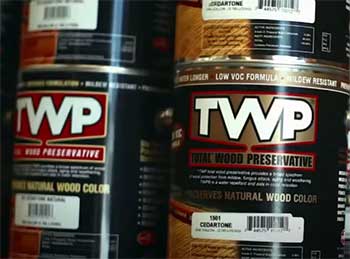
TWP Stains, especially the 100 Series, are a pro favorite for their deep penetration and UV resistance.
I used TWP on a neighbor’s deck, and it held up well for about three years.
However, TWP is pickier about application conditions—you can’t apply it in direct sun or on hot days, unlike Armstrong Clark, which I slapped on during a 90-degree afternoon with no issues.
TWP’s maintenance requires more scrubbing to remove old layers, while Armstrong Clark’s no-strip recoating is a time-saver. Both offer rich colors, but Armstrong Clark’s samples were truer to the final result. If you’re a pro with perfect prep, TWP might edge out, but for DIYers, Armstrong Clark’s ease wins.
- Armstrong Clark Vs. Cabot Semi-Transparent Stain
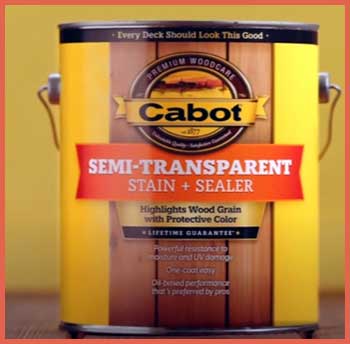
Cabot’s Semi-Transparent Stain is a budget-friendly option I tried on a pergola years ago.
It’s thinner than Armstrong Clark, absorbing quickly, but it faded noticeably within 18 months, while my Armstrong Clark deck still looked vibrant after three years.
Cabot’s application is straightforward, but it doesn’t condition the wood like Armstrong Clark’s dual-oil formula.
Maintenance is a hassle with Cabot—you need to strip or sand before recoating, unlike Armstrong Clark’s simple clean-and-apply approach.
Cabot’s price is lower (around $40/gallon), but Armstrong Clark’s longevity makes it a better investment for lasting beauty.
- Armstrong Clark Vs. Sherwin-Williams SuperDeck
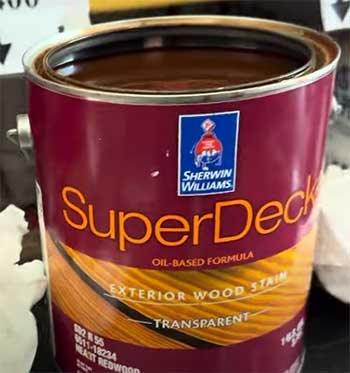
Sherwin-Williams SuperDeck is a solid oil-based stain I tested on a fence.
Its color retention was decent, lasting about two years, but it didn’t match Armstrong Clark’s three-year vibrancy on my deck.
SuperDeck’s application is forgiving, like Armstrong Clark, but it felt stickier and took longer to dry—about 24 hours versus Armstrong Clark’s rain-ready finish in an hour.
SuperDeck requires light sanding for maintenance coats, which adds work compared to Armstrong Clark’s no-sand recoating. SuperDeck’s colors are bold, but Armstrong Clark’s non-drying oils give wood a more rejuvenated look.
- Armstrong Clark Vs. BEHR Exterior Wood Stain
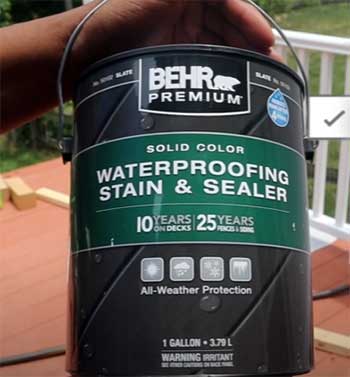
BEHR’s Exterior Wood Stain is widely available, but it disappointed me on a deck project.
Within a year, it started peeling, trapping moisture under its film-like finish.
Armstrong Clark, by contrast, never peeled, thanks to its penetrating oils.
BEHR’s application was messy, with lap marks if I wasn’t careful, while Armstrong Clark went on smoothly even in heat.
BEHR’s maintenance is a nightmare—stripping is mandatory—whereas Armstrong Clark’s fade-out formula makes recoating a breeze.
BEHR is cheaper (about $35/gallon), but Armstrong Clark’s durability and low upkeep make it worth the extra cost.
Frequently Asked Questions (FAQ)
Armstrong Clark stain typically lasts 2-3 years on horizontal surfaces like decks and up to 5 years on vertical surfaces like fences or siding. My cedar deck still looked vibrant after three years with minimal fading. Longevity depends on wood type, prep, and weather exposure, but proper maintenance can stretch its life.
Absolutely. It’s top-rated by pros and homeowners for its ease of application, durability, and wood-conditioning properties. I’ve used it three times in 10 years, and it never peels or cracks. Its ability to be applied in direct sun and resist rain after an hour makes it a standout.
TWP 100 Series often takes the top spot for its UV protection and penetration, but Armstrong Clark is a close second. In my experience, Armstrong Clark’s easier application and lower maintenance needs make it a better choice for DIYers, though TWP shines for professional-grade projects.
Semi-solid stains like Armstrong Clark’s Mountain Cedar or TWP’s Pro-Series last the longest, typically 3-5 years on decks and longer on vertical surfaces. I found Armstrong Clark’s semi-solid formula outlasted thinner stains like Ready Seal, especially in harsh climates, thanks to its high solid content and dual-oil protection.
Final Verdict
After walking you through my entire journey and the detailed breakdown of this product, my conclusion is simple and unwavering. If you value your time, your back, and the long-term health of your wood, then you should absolutely buy Armstrong Clark stain.
It frees you from the vicious cycle of stripping and sanding that plagues so many other deck finishes.
It’s a premium product with a price to match, but the investment pays you back every year you don’t have to face a peeling, flaking mess. This is the stain for people who want to do the job right once and then enjoy their deck for years to come.
